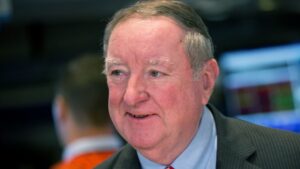Remembering Art Cashin: A Lasting Legacy on Wall Street
The world of finance has lost one of its iconic figures. Art Cashin, the longtime director of floor operations at the New York Stock Exchange (NYSE) and a familiar face on CNBC for over 25 years, passed away at the age of 83. His contributions to market commentary and trading culture have left a significant mark on Wall Street that can’t be easily replicated.
A Respected Voice in a Competitive Arena
Art Cashin was often referred to as “Wall Street’s version of Walter Cronkite.” In an arena known for its cutthroat competition and often polarized opinions, Cashin managed to garner respect from all sides—be they bulls or bears, liberals or conservatives. His ability to engage with a diverse range of opinions while maintaining relationships with nearly everyone was nothing short of extraordinary.
In an ever-changing market environment, Cashin was a beacon of stability. His insights often came with a mixture of charm and wit that drew viewers in and made the complexities of Wall Street accessible to the average investor.
The Raconteur of the Exchange
Beyond his market acumen, Cashin was known for his storytelling prowess and unique social rituals. Every day after trading closed, he gathered with friends at the NYSE luncheon club or at Bobby Van’s Steakhouse, where they affectionately dubbed themselves the "Friends of Fermentation." His drink of choice? Dewar’s on the rocks. For Cashin, these gatherings were not just about unwinding; they were a ritual that fostered relationships and shared experiences within the tightly-knit community of traders.
A Traditionalist in a Modern Age
Despite the modernization of trading, Cashin remained a traditionalist at heart. He famously eschewed credit cards in favor of cash, believing it safeguarded his anonymity in a world that often seeks the limelight. His notes—handwritten and meticulously compiled—reflected an old-school dedication to his trade that was increasingly rare in an age dominated by technology.
His physical workspace often resembled a chaotic archive of decades of market history, filled with papers and reports, indicative of a meticulous yet nonconformist approach to trading.
A Committed Trader and Observer
Born in Jersey City, NJ, in 1941, Cashin began his career in finance at the tender age of 17. After overcoming personal adversity, including the untimely death of his father, he rose through the ranks to become a member of the NYSE at just 23 years old. His innate ability to read market sentiments—often based on the audible chaos of the trading floor—set him apart. He noted that the pitch of the traders’ voices could signal market movements weeks before algorithms took over.
He ran for mayor in the mid-1970s, though he quipped that his honesty relegated him to a poor showing among other candidates—an experience that underscored his straightforward nature.
Resilience Amidst Tragedy
Cashin’s life wasn’t without its dark moments. The aftermath of the September 11 attacks profoundly affected him. Escaping from Ground Zero, he shared a poignant reflection on the solidarity and support felt amongst New Yorkers in those chaotic hours. His empathy and genuine human connection were hallmarks of his character, reinforcing the notion that despite the challenges, community resilience is paramount.
In the wake of 9/11, he chaired the NYSE "Fallen Heroes Fund," ensuring that the families of first responders received the support they needed—a testament to his commitment to serving his community.
Legacy of Insight
Cashin’s daily market analysis, known as Cashin’s Comments, blended historical events with present market realities. His insights on human psychology and market behavior were not just educated guesses but a culmination of years spent observing traders, their fears, their reactions, and their instincts.
He often warned of the dangers of knee-jerk reactions, which many investors succumb to during volatile market moments. “Those who react immediately rarely do well,” he cautioned, highlighting the importance of patience and careful analysis.
Conclusion: The End of an Era
Art Cashin exemplified what it meant to be a trader and a storyteller on Wall Street. His deep understanding of market dynamics, combined with his unique approach to human connections, made him a beloved figure both on the trading floor and in the households of countless viewers.
His passing marks the end of an era, but his legacy will undoubtedly live on in the principles he espoused and the community he fostered. To honor his memory, consider donating to the Arthur D. Cashin Jr. Memorial Scholarship at Xavier High School, ensuring his commitment to education and integrity continues to inspire future generations.
At Extreme Investor Network, we strive to carry on that legacy of integrity, insight, and community. Join us as we continue to navigate the complexities of the financial markets with the wisdom that pioneers like Cashin have imparted to us.

